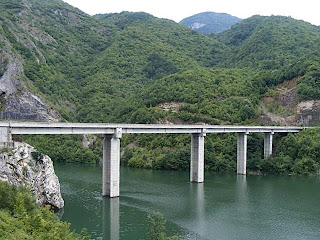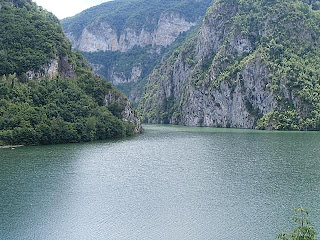Approaching Shkoder, the ruins of the Rozafa Castle, on a 130 m height hill, attract you immediately. The castle is important for the Albanian history, as it was once the capital of the Illyric kingdom. This castle is connected with the legendary Queen Teuta (who followed her husband, Agron, the founder of the kingdom). She led some pyrate attacks on the vessels from the Adriatic Sea, including the Roman commercial vessels. Because her refuse to cease the attacks, the Roman legions attacked the castle and conquered it in 167 BC.
There is also a legend who tells us that the name of the castle came from that of the wife of the youngest brother, among the 3 brothers who built the castle. Because the walls kept falling down every day, they decided to built into the walls the wife who will come the first, next morning, to bring them food. It was Rozafa who was sacrificed. This is a legend common for the whole Balkan space. We, in Romania, have it under the “Legend of the Manole Master”, who built a wonderful monastery at Curtea de Arges.
The access by car to the castle entrance could be done but the parking is very small and steep. So it is better to leave the car beneath the hill, and you go by feet 1.5.km. It is a parking there, which costs 1 euro. The entrance fee into the castle is of 200 lek or 2 euros. After a very small inner court, serving to the castle guards, the visitor finds himself in a second court from were he has very nice views over the surroundings. This include the Shkodra Lake, the rivers, the town and the Lead Mosque (no more in use). In the same inner court, there are the ruins of two round wells, connected with a cystern for water for the castle, and the ruins of a church built during XIIIth century. It played the role of cathedral once, but later it was transformed into a mosque. The walls display some unusual open arches. The ruin of the tower are interesting, made of red brick, in Byzantin style.
The last court is a small one, were the little museum is. Some children were there, with their teacher. They stayed in the shadow, as it was very warm outside. A little cafe offers also some shadow and a good panorama. We could not leave without a last look to the Shkodra Lake.
Cand te apropii de Shkoder, iti atrag atentia imediat ruinele Cetatii Rozafa, care strajuiesc orasul de la inaltimea de 130 m a dealului pe care se afla. Pozitia sa este una strategica, aflandu-se la unirea a doua rauri importante, Buna si Drini. De acolo, de sus, intinderea albastra a Lacului Shkodra lasa impresia unei mari interioare, in care se oglindesc muntii.
Inainte de a fi istorie, Rozafa este legenda. O legenda care se regaseste in intreg spatiul balcanic, intruchipata la noi de povestea Mesterului Manole. Si aici, spune legenda, fratele cel mai mic (dintre cei trei care au construit cetatea) si-a zidit sotia, pe Rozafa, pentru a asigura rezistenta cetatii.
Istoria sa este legata de cea a ilirilor, carora le-a apartinut pana in anul 167 i.e.n., cand a fost cucerita de catre romani. Dintre conducatori se distinge figura unei regine legendare, Teuta, care a condus Iliria dupa moartea sotului ei, Agron, intemeietorul regatului. Initiatoare a unor atacuri pirateresti asupra corabiilor din zona, inclusiv cele ale romanilor, Teuta a refuzat sa le puna capat, ceea ce a atras atacurile Romei. In 167 legiunile romane au cucerit Rozafa dar au mai lasat-o pe Teuta pe tron in schimbul platii unui tribut si a recunoasterii lor. In interiorul tarii, Iliria a mai dainuit un timp ca si regat independent. Chipul Teutei, considerata de albanezi o eroina a lor, se afla pe moneda de 100 lek.
La cetate se poate ajunge pana sus si cu masina dar parcarea este mica acolo, incap doar cateva masini, si este in panta mare. Exista insa si la poalele dealului o parcare (100 lek, mai putin de un euro). Pietrele cu care este pavata calea de acces (cca. 1.5 km) sunt neregulate ca marime si foarte lustruite, asa ca este nevoie de pantofi cu o aderenta buna si de atentie. Nu putine doamne am vazut coborand cu pantofii in mana…
Intrarea in cetate costa 200 lek si este mai bine sa o platiti in moneda nationala. Altfel, veti plati putin mai mult, adica 2 euro/persoana. Cel mai mare minus il constituie absenta unor explicatii, cu exceptia celor de la intrarea in castel. Exista insa un mic muzeu, care incearca sa reconstituie istoria, unde mai intelegi cate ceva. In rest, trebuie sa te bazezi pe informatii culese de pe internet.
Imediat la intrare este o foarte mica curte interioara, utilizata de catre garzile cetatii, apoi o a doua curte, mult mai mare, de unde ochiul poate cuprinde deja imprejurimile cetatii. In vale, se vede o moschee dezafectata, numita Mocheea de Plumb. Acoperisurile rosii se detaseaza pe fondul verde al vegetatiei.
Tot aici se vad si ruinele Bisericii Sf. Stefan, odinioara catedrala, construita in secolul al XIII-lea. Ruinele turnului din caramida rosie releva stilul bizantin de constructie. Mai tarziu, a fost transformata in moschee. Interesante sunt arcurile deschise de pe peretii laterali. In apropiere se afla doua puturi circulare, legate de cisternele in care se colecta apa pentru cetate.






























